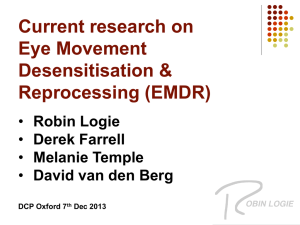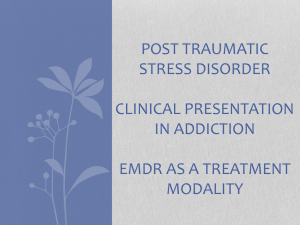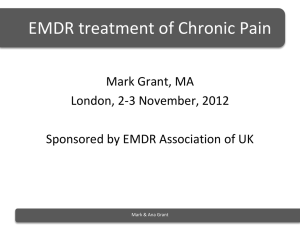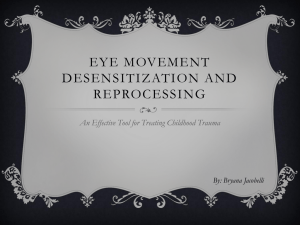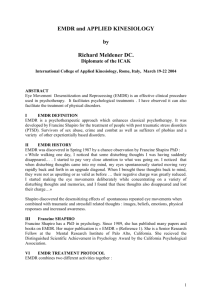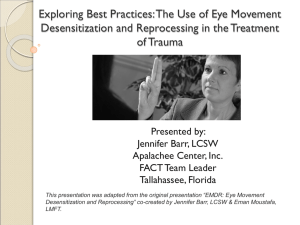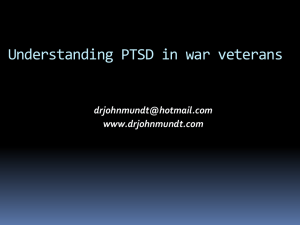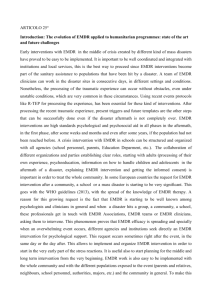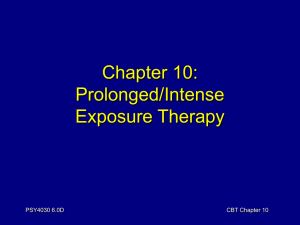Presentazione standard di PowerPoint
advertisement
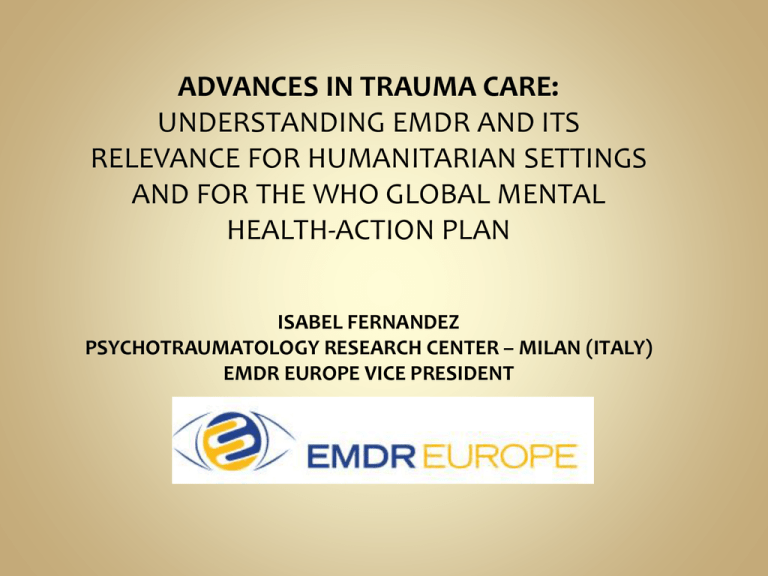
ADVANCES IN TRAUMA CARE: UNDERSTANDING EMDR AND ITS RELEVANCE FOR HUMANITARIAN SETTINGS AND FOR THE WHO GLOBAL MENTAL HEALTH-ACTION PLAN ISABEL FERNANDEZ PSYCHOTRAUMATOLOGY RESEARCH CENTER – MILAN (ITALY) EMDR EUROPE VICE PRESIDENT Eye Movement Desensitization and Reprocessing is a form of psychotherapy designed to (1) reduce trauma-related stress, anxiety, and depression symptoms associated with posttraumatic stress disorder (PTSD); and (2) improve overall mental health functioning. EMDR has structured protocols designed to achieve the best possible treatment effects. EMDR therapy is recognized as an evidence-based practice because it has been scientifically evaluated, demonstrated to be effective, and often cited as an effective treatment in national and international treatment guidelines for organizations such as: the U.S. Department of Veteran Affairs, the U.S. Department of Defense, the United Kingdom Department of Health, and the International Society of Traumatic Stress Studies. In 2010, EMDR was reviewed and included in the Substance Abuse and Mental Health Services Administration’s National Registry of Evidence-based Programs and Practices (USA). “Trauma” is seen as any life experience that has a negative on going impact on the life of the person In the long run what causes disturbance is not the traumatic experience but its memory (van der Kolk, 2000) Unprocessed memories of disturbing life events are the foundation of pathologies In the Adverse Childhood Experiences (ACE) study by Kaiser Permanente and the Centers for Disease Control 17,337 adults: • 11% reported having been emotionally abused as a child, • 30.1% reported physical abuse, • 19.9% sexual abuse; • 23.5% exposed to family alcohol abuse, • 18.8% to mental illness, • 12.5% witnessed their mothers being battered • 4.9% reported family drug abuse. …The study unequivocally confirmed earlier investigations that found a highly significant relationship between adverse childhood experiences and depression, suicide attempts, alcoholism, drug abuse, sexual promiscuity, domestic violence, cigarette smoking, obesity, physical inactivity, and sexually transmitted diseases. In addition, the more adverse childhood experiences reported, the more likely a person was to develop heart disease, cancer, stroke, diabetes, skeletal fractures, and liver disease. Felitti VJ, Anda RF, Nordernberg D, et al. Relationship of childhood abuse to many of the leading causes of death in adults: the adverse childhood experiences (ACE) study. Am J Prev Med. 1998; 14(4): 245-258. The long-term costs of traumatic stress: intertwined physical and psychological consequences A.C. MCFARLANE OFFICIAL JOURNAL OF THE WORLD PSYCHIATRIC ASSOCIATION (WPA) Volume 9, Number 1 February 2010 WHO Guidelines Review Committee has formally approved the use of EMDR therapy with adults and children for the treatment of PTSD. Trauma-focused CBT and EMDR therapy are recommended for children, adolescents and adults with PTSD. Like CBT with a trauma focus, EMDR therapy aims to reduce subjective distress and strengthen adaptive cognitions related to the traumatic event. Unlike CBT with a trauma focus, EMDR does not involve (a) detailed descriptions of the event, (b) direct challenging of beliefs, (c) extended exposure, or (d) homework. World Health Organization (in press). Guidelines for the management of conditions that are specifically related to stress. Geneva, WHO. Brief eclectic psychotherapy v. EMDR therapy for PTSD: randomized controlled trial Mirjam J. Nijdam, Berthold P. R. Gersons, Johannes B. Reitsma, Ad de Jongh and Miranda Olff BJP 2012, 200:224-231. • Results: Both treatments were equally effective in reducing PTSD symptom severity, … • EMDR led to a significantly sharper decline in PTSD symptoms than brief eclectic psychotherapy, with similar drop-out rates • Conclusions: Although both treatments are effective, EMDR results in a faster recovery compared with the more gradual improvement with brief eclectic psychotherapy. Phobias (de Jongh, Ten Broeke & Renssen, 1999; de Jongh, et al., 2002), Panic disorder (Goldstein et al., 2000; Fernandez & Faretta, 2007), Generalized anxiety disorder (Gauvreau & Bouchard, 2008), Conduct problems and self-esteem (Soberman, Greenwald & Rule, 2002), Complicated mourning (Solomon & Rando, 2007), Body dysmorphic disorder (Brown, McGoldrick & Buchanan, 1997), Olfactory reference syndrome (McGoldrick, et al., 2008), Sexual disfunction (Wernik, 1993), Pedophilia (Ricci et al., 2006) Performance anxiety (Barker & Barker, 2007), Chronic pain (Grant & Threlfo, 2002), Migraine headaches (Marcus, 2008), Phantom limb pain (Schneider et al., 2008; de Roos, Veenstra et al., 2010). “Hard Core” mental illness: Sz., Depression Psychological First Aid (Acute interventions) Autism Retardation Mutism Medically Unexplained Physical Symptoms Cancer Psychosis • Psychological interventions are performed in greatly unstable settings, while facing acute stress responses and emotional pain. • Also, these acute responses produce a longterm effect on physical and mental health (NIMH,NICE, EFPA). Every country has to develop approved psychological interventions, which must be implemented on a wider scale (Council of Europe, Major Hazards in Europe Document, 2007) • • Vienna Manifesto for Psycho-social Acute Care (2000) World Health Organization (2011): Psychological First Aid The Council of Europe has established that citizens must have free basic assistance in case of disaster, and its implementation must be incorporated within the legislation and be part of the emergency plan programmes After 12 months, 10% where diagnosed a PTSD%, yet 16% had Major Depression, 11% a General Anxiety Disorder, 9% Agoraphobia, 6% panic attacks, 6% specific phobias, 4% an Obsessive- Compulsive Disorder. (Bryant, 2011) Others develop symptoms much later. This could be given by the process of sensitization caused by traumatic memories, enabling threshold symptoms to occur more significantly over time (McFarlane, 2009). Prevention, EMDR and the role of psychosocial support are the most studied and published topics in the literature of disasters. Treating children survivors of natural and manmade disasters with EMDR in the acute phase (plane crash over their school, earthquakes, school bus accidents, motor trafic accident, flood) 725 CHILDREN AND ADOLESCENTS Begins in acute phase (before 3 months) Treatment provided to all victims (not only those with PSTD) – Individual and/or group EMDR sessions - Delayed group when possible Consecutive days/No homework Pre and post treatment measures (one week before and one week after treatment, so results could be more related to EMDR treatment) – Follow-up at 6 months and one year – Parents included in treatment when possible These projects have been carried out as a cooperation between Mental Health Public Services and the Italian EMDR Association. EMDR treatment was agreed upon and supported by the National health service, the authorities, the school personnel and by the parents of the children treated. EMDR practitioners went to the disasters sites on a probono basis EMDR was part of an extensive and comprehensive program of psychosocial support with the local population. EMDR sessions and treatment logistically based in school. an earthquake in 2002 (27 children died in a school building) a plane crash in a school building in 2002 a bus accident during a school trip in 2007 (2 children died, many seriously wounded) a car accident downtown in 2007 (1 girl died and some seriously injured) A flood in 2008 Aquila’s earthquake 2009 School bus accident 2010 TREND OF CLINICAL AND SUBCLINICAL POST TRAUMATIC REACTIONS 100 88% 80 60 77% 61% 63% 69% 78% 67% 64% 63% >50% 49% 40 >17% 20 0 DSM EARTHQUAKE SCHOOL BUS ACCIDENT ROAD TRAFFIC ACCIDENT FLOOD EARTHQUAKE (6M) EARTHQUAKE (1Y) ACUTE POST TRAUMATIC REACTIONS CHRONIC POST TRAUMATIC REACTIONS SCHOOL BUS ACCIDENT 80 70 60 50 40 30 20 10 0 63% 64% 63% 9% EARTHQUAKE 77% 69% SCHOOL BUS ACCIDENT 12,5% 4% 5% ROAD TRAFFIC ACCIDENT PRE-EMDR 5% FLOOD POST-EMDR EARTHQUAKE EMDR is effective for acute PTSD and useful in achieving immediate relief and long-term recovery, in children who are primary victims of disasters. EMDR is effective for chronic PTSD EMDR is effective for subclinical PTSD Grief and trauma not only in the individuals and their families but also in the group and community Both children and parents and the community involved in disasters share all post-traumatic reactions, mourning processes, loss of homes, sense of guilt and conflicts that usually arises among survivors Children more than adults can have chronic PTSD, longlasting reactions, which do not resolve on spontaneous recovery (they tend to raise instead). There is need to raise awareness of the possibile psychological consequences, since these traumatic experiences can create vulnerability, not only PTSD. Child’s symptoms in these interventions have been acknowledged, validated, normalized and treated EMDR facilitates narrative….Children often have fewer opportunities to discuss and process their trauma. Adults usually avoid talking about the trauma to “protect” them, so it becomes difficult for young children to verbally describe internal states and memories. Besides the trauma processing, EMDR treatment enables children to go through the mourning process in a natural way, to enhances the child’s resources, reduces stress reactions and normalizes behaviors. The earthquake effects have had national implications. It caused long-lasting feelings of fear and impotence. People had also feared for a long time, that the event might happen again, disrupting a sense of safety in the individual and in the entire comunity. As there had been two major earthquakes, the traumatic effects had a stronger impact and affected many areas of the comunity. The goal of our intervention was to reestablish a psychological balance, reduce traumatic stress responses and enable people to return to their homes, to their jobs and to function again in society. - From June 2nd to August 30th - 100 EMDR clinicians - Administered 61% of total interventions in Emilia Interventions were implemented in collaboration with and supported by the NHS of the city of Modena 2089 people contacted the psychological support centers in the affected area 1136 people have been treated with EMDR individually or in groups Most of the interventions were completed in the acute phase, others have been referred to the local services Administration of IES (Impact of Event Scale) Pre-treatment Post-treatment intrusivity 18,67% 9,78% avoidance 13,22% 9,41% hyperarousal 14,9% 7,02% Brief intervention, immediate effects of treatment Psychophysiological dearousal response, decrease in vividness of imagery Can be administered on consecutive days without homework It prevents the accumulation of traumatic memories It can enhance resiliency, which is an important factor when facing chronic situations Emdr enables: The monitoring of symptoms and responses To provide immediate emotional support The managing of emotions, evaluating and strengthening resources Its administration at an individual and group level People are able to describe the event (cognitive structuring) and talk about their feelings and emotions (in a safe setting) The sample: 40 people, 10 years after the earthquake 22 women and 18 men Average age = 36,20; DS =16,23; Range=15-72 Present PTSD Diagnosis (DSM-IV-TR criteria) -Present 19 -Absent 21 (12 underthreshold) Past PTSD Diagnosis (after the 2002 earthquake) -Present 29 -Absent 11 (11 underthreshold) Diagnosi Asse I DSM-IV-TR Present Past (Current Comorbidity) (Past Comorbidity) 14 13 MAJOR DEPRESSION 8 10 BIPOLAR DISORDER 1 1 PANIC ATTACK DISORDER 5 5 SPECIFIC PHOBIA 2 1 SOCIAL PHOBIA 1 0 27 28 PRESENT DISORDERS - TOTAL NO DISORDERS 40 SUBJECTS Comparison pre-EMDR - post-EMDR SGP – pre (n = 20) SGP – post (n = 20) CAPS – Re-experiencing/intrusion*** 13.25 (9.34) 3.55 (4.16) CAPS – Avoidance/numbing*** 17.90 (8.49) 8.10 (1.49) CAPS –Hyperarousal*** 14.35 (5.63) 7.40 (4.80) IES – Total*** 30.70 (18.39) 18.45 (16.08) IES – Intrusive*** 16.45 (10.70) 8.55 (7.58) IES – Avoidance* 14.25 (10.69) 9.90 (9.41) BDI – Total** 13.45 (7.66) 7.40 (6.41) SCL-90-R – Positive Symptom Distress Index* 1.63 (0.42) 1.26 (0.57) All Data are mean (SD); pairwise comparison p-values: * p < 0.05, ** p<0.01, ***p < 0.001. FINAL COMMENTS The intervention and the EMDR processing of traumatic memories related to these experiences, not only minimizes risk factors, but also serves as a protective factor for possible further occuring life events A systematic and structured help treatment is available and should be provided to the population exposed to mass disaster EMDR treatment (typically 4/6 sessions) is easily administered, it focuses on the memory of the traumatic event and results are visible after one week. Intervening on the psychological aspects in the aftermath of a natural or manmade disaster is an issue for public and mass health. EMDR IS PROVING TO BE AN EFFECTIVE CONTRIBUTION IN THIS FIELD
